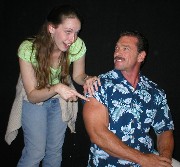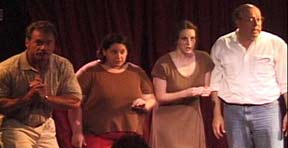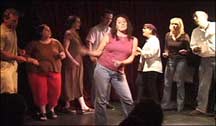GAMES
SOME SPOLIN GAMES USED IN PERFORMANCE:
(NOTE: NOT ALL GAMES LISTED APPEAR IN EVERY SHOW)

EMOTIONAL SYMPHONY is like a shot of adrenalin giving instant energy to the players and connecting them with the audience. Each player is assigned an emotion by the audience. The ensemble is then conducted through an opening “overture.”
GIBBERISH RELAY is another high energy  game involving the entire cast immediately as the player in the middle must translate back and forth between players on either side who speak in gibberish.
game involving the entire cast immediately as the player in the middle must translate back and forth between players on either side who speak in gibberish.
INTENSIFY EMOTIONS. The audience suggests who and where two players are, and, a third player calls out new emotions which they must incorporate.
ANIMALS. After the audience assigns each player an animal, the players must explore the animal physically, verbally, then interact with each other as animals, and finally bring the animals up into human forms with attitudes and traits intact.

CAMERA. Here the focus is on focus. As two players do a scene of the audience’s choosing, a third player calls out “camera” alternating between the two players, “both camera” or” no camera.” The players much shift between giving full mental and physical attention, like the lens of a camera, to each other.
CONTACT. Players do a scene in which dialogue can only occur when some form of physical contact is made.
DUBBING. In much the same manner that a foreign film appears on late night TV, two players take a film genre and a relationship and do a scene from a movie, while two other players dub in their voices live.
WHO AM I? A player is sent out of earshot and upon his return must interact with fellow players until he is aware of the famous or occupational identity the audience has chosen for him. Who am I?
GIBBERISH/ENGLISH. The audience suggests  who and where two players might be, while a third player/sidecoach switches them unexpectedly between English and Gibberish throughout the scene.
who and where two players might be, while a third player/sidecoach switches them unexpectedly between English and Gibberish throughout the scene.
GIBBERISH INTERPRETERS. Two players take turns giving a speech on a subject of the audience’s choosing. One player orates in gibberish. The other interprets in English.
HOLD IT. Each player is given a “life script” like” the grass is always greener.” The group then incorporates that script into their characters as they go through scenes as children, teens, middle-agers, and finally elderlies.
INTERMISSION. The players retreat to the sidelines for a few moments to towel down, consume beverages and gossip, while the audience does the same thing.
MADRIGAL. A small group of players with musical accompanyment improvise a 90’s rendition of the medieval ditty which often communicated on subjects of public concern.
MAGIC MUSIC. The audience selects a physical task for a hidden player to do upon his return to a prop-littered stage. By singing a children’s song louder for warmer, and softer for colder, the player is guided into completing the task. This is often repeated with an audience volunteer!
POETRY. There are many styles of poetry. Limericks, haiku, rhyming, non-rhyming, jazz-like free-style, etc. Based on a first line from the audience, each player improvises a poem in his own particular style.
Limericks, haiku, rhyming, non-rhyming, jazz-like free-style, etc. Based on a first line from the audience, each player improvises a poem in his own particular style.
SCENE ON SCENE. The principle of “Give-and-take”is the foundation that Spolin games are built on. In scene on scene, two players on one side of the stage reminisce based on a relationship the audience gives them, while two other players on the other side of the stage enact various beats or moments of the reminiscence.

SINGING DIALOGUE. Two players do a scene based on the audience’s suggestion of who and where they are. All the dialogue is sung!
SLOW/FAST. Two players, given who and where they are, begin a scene. A sidecoach freezes them at one point and they must goback and repeat the scene in slow motion, and then again in fast motion. Then they are allowed to continue the scene to completion.
STAGE WHISPER. Two players must do a scene entirely in stage whisper after the audience suggests characters and a setting fraught with impending danger or require secretiveness.

BUILDING A STORY The entire cast is seated on stage and tells an improvised story, relay-style, based on an audience title.
BUILDING A SONG The entire cast is sings a song, relay-style, based on an audience title.
TRANSFORMATIONS. Two players begin a physical activity of the audience’s choosing. Through a series of movements, changes,verbal and non-verbal interactions with each other and other players who join in, they eventually transform their activity into a group involvement, which the audience has also chosen.
activity into a group involvement, which the audience has also chosen.
WHATS BEYOND? Usually three players begin a scene. At some point action is frozen and one player is sent out. Audience members help conjure up some secret that the two remaining players have discovered about the third. They then interact with the returning player until he understands the “what’s beyond?“

